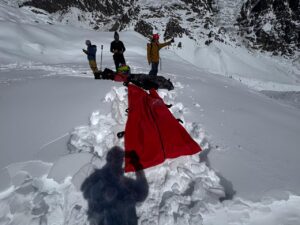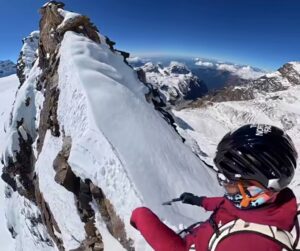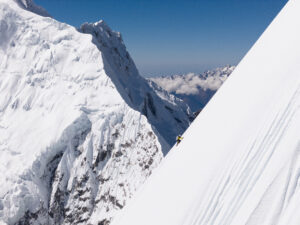Piolet d’Or winner Yasuhiro Hanatani is leading a Japanese team in the Ohmi Kangri Himal west of Kangchenjunga. They will attempt a first ascent of 6,076m Sharphu VI and 6,164m Sato (or Sat) Peak in the Sharphu group of mountains.
This is part of Hanatani’s Himalaya Camp Project, which he started in 2015 to promote exploratory alpinism among young climbers.

The Sharphu group. Photo: Climbing Himalaya
The team also includes Saki Terada, Takahiro Kaneko, and Takahiro Ishikawa. The team will begin climbing next month and finish by November. Four will attempt Sharphu VI and three will go for Sato Peak.

From left to right, Takahiro Ishikawa, Takahiro Kaneko, Yasuhiro Hanatani, and Saki Terada. Photo: Himalaya Camp
The Sharphu group of mountains (I-VI) lies west-northwest of Kangchenjunga. All peaks in this group surpass 6,000m. The highest of them, 6,433m Sharphu I, was first climbed on October 22, 1963, by Yuzo Tatsumi, Takao Ishinabe, and Chiharu Miyamoto of Japan. One year earlier, in 1962, another Japanese party led by Sasuke Nakao climbed nearby 6,172m Nupchu I (wrongly called Sharphu IV in some accounts).

Photo: Stefano Ragazzo
Past Sharphu climbs
Climbing was banned in this area for decades and only reopened in 2002. Spencer Gray (U.S.) and Aivaras Sajus (Lithuania-U.S.) first climbed Sharphu II (6,328m) on October 26, 2018. No one has climbed it since then, according to The Himalayan Database. Sharphu I and II are twin peaks, while both 6,220m Sharphu III and 6,076m Sharphu VI remain unclimbed. Sharphu VI is one of the targets for Hanatani’s group this autumn.
Stefano Ragazzo and Silvia Loreggian attempted 6,164m Sato Peak in the autumn of 2022. They planned to ascend the north face, but unconsolidated snow prompted them to change that to the east-southeast ridge. After a six-hour climb, the Italians reached the (eastern) foresummit at 6,100m. The main peak lay another 100m away. Because of bad snow, they did not continue to the main peak. They named this foresummit Sato Pyramid.

The Ghamubar peaks, seen from Dalkot village. Photo: Yudai Suzuki
Ghamubar Zom
As we reported earlier, the Japanese team of Yudai Suzuki, Kei Narita, and Yuu Nishida are currently in Pakistan. The initial plan was to attempt the first ascent of the north face of 6,518m Ghamubar Zom in the Hindu Raj range in Gilgit-Baltistan. The party established a base camp at 3,400m at the end of August, then went up to 4,750m for acclimatization.

The Japanese party on Ghamubar Zom V. On their first push, they reached 5,700m. Photo: Yudai Suzuki
After that, according to Suzuki, they changed plans about ascending the north side of the Ghamubar massif, because of several huge seracs.
Instead, the trio decided to attempt Ghamubar Zom V by its unclimbed north-northwest ridge. That stretches more than 2,000m and ends at the 6,400m northwest summit of Ghamubar V. This summit is unclimbed and is quite independent from other Ghamubar peaks.
In the first attempt, they had to retreat from 5,700m. They then decided to take a one-week rest in nearby Dalkot village. On the way, they discovered that the bridge of the trekking route had collapsed. When they returned to base camp, they found out that a cow had chewed holes in their tents. They managed to fix them with duct tape.

Today, ExplorersWeb heard from Yudai Suzuki. He says that they will make another attempt on Ghamubar Zom V, this time via the northwest ridge. The entire north side of the massif remains unclimbed, although a French party attempted it in the past.






